Brazilian singer Laura Monteiro is murdered in her dressing-room by her jealous lover João Fernandes de Oliveira when he discovered she was cheating on his with Assis and planning to escape ... Read allBrazilian singer Laura Monteiro is murdered in her dressing-room by her jealous lover João Fernandes de Oliveira when he discovered she was cheating on his with Assis and planning to escape from him and go to Buenos Aires with Assis. Meanwhile, Belén Moreira, who lives in Favela ... Read allBrazilian singer Laura Monteiro is murdered in her dressing-room by her jealous lover João Fernandes de Oliveira when he discovered she was cheating on his with Assis and planning to escape from him and go to Buenos Aires with Assis. Meanwhile, Belén Moreira, who lives in Favela do Salgueiro and is a dead ringer for Laura, goes to Copacabana with her boyfriend Paulo. ... Read all
- Oliveira's lawyer
- (as Jose Prada)
- Paulo's friend
- (as Antonio Sampaio)
- White gangster
- (as Alvaro Aguiar)
- Copacabana seducer
- (uncredited)
- Man in samba school committee
- (uncredited)
You haven't lived until you see Sarita appear on a stage amidst dozens of dancers in "typical Brazilian" costumes and a lot of stage smoke as Yemanjá (the Candomblé goddess of the seas) in a bare-legged costume complete with blue wig, glittering make-up and star-shaped magic wand, and start to sing Ary Barroso's classic patriotic standard "Brazil/ Aquarela do Brasil" -- that originally describes Brazil's natural beauties -- in a Spanish version that talks about being dumped by a cruel-hearted lover! You can't miss Sarita bravely climbing up her beloved favela hill in vaporous dress, high-heeled shoes, helmet-like hairdo and lemon-sized jewels, just to be accused -- falsely! -- of being a slut by an envious hag, who provokes Sarita so much they end up in a nasty hair-pulling fistfight, rolling on the ground with "accidental" skirt-raising! Or Sarita dancing the samba (struggling to, anyway) barefoot on top of the Sugar Loaf... or crooning a sort of samba-salsa accompanied by a choir of favela kids singing in totally dubbed high-pitched soprano voices in Spanish! Got the idea?
Though the film was made on fantastic locations (Copacabana, the Corcovado, Rio's Theatro Municipal, the favelas, Brasília, Bahia), to believe that Sarita could play a girl -- hm, let's say "youngish" woman -- from a Rio favela is REALLY stretching it (Claudia Cardinale fared somewhat better in "Una Rosa per Tutti" the following year, her physique and darker skin not too unlike a carioca woman). Well, one could argue -- rightfully -- that John Wayne once played a Mongol, Brando a Japanese and Katharine Hepburn a Chinese...
Kitsch, unbelievable, tacky, for sure, but one thing must be said for Montiel: she's never caught blasé or bored, she really goes for it, whether it's the fistfight, the songs or her prayer for Yemanjá. We get a feeling she's happy as long she can wear fancy costumes, lush wigs, expensive jewels and a ton of make-up. She seems eager to sing her songs and do her close- ups, and the producers wisely valued their 37 year-old star: the only other female roles of any importance in the film are the Hattie McDaniel-ish housemaid Trinidad (how about that for a Brazilian name?!) played by the rotund Zeni Pereira, and Sarita's GRANDmother (!), played by 70 year-old Antonia Marzullo (real-life grandmother of celebrated Brazilian actress Marília Pêra, of "Pixote" fame).
The best in "Samba" are the musical numbers, in the so-outlandish-it's-fun way: Sarita's undeniably expressive singing voice -- perfectly suited to melodramatic Latin torch songs, especially boleros -- found the least adequate possible material here: Brazilian sambas and sambas-canções require either swinging zest or vocal subtlety, neither of which is Montiel's forte. Yet, she does try: she even sings Dolores Duran's classic "A Noite do Meu Bem" in a dialect that vaguely resembles Portuguese:)
This vintage kitsch time-capsule will probably interest only Montiel's fans, but nostalgic/curious Brazilians may want to have a look at mid-60s Rio and then newly-built Brasília, as well as seeing a VERY young Antonio Pitanga (billed as Antonio Sampaio), cameos by Grande Otelo, Wilson Grey and great samba singer Ciro Monteiro as the President of Salgueiro Samba School (it's a shame he doesn't get to sing, but then ONLY Sarita sings in the film). Brazilianist film buffs will add a precious item to their collection on "How Hollywood and Europe got it all wrong about Brazil once again". My vote: 6 out of 10 -- this rating would be higher if the Brazilian DVD copy wasn't so bad: the colors are washed out and the sound sync is awful, but somehow it just adds to the kitsch, and I'll bet Sarita's fans will scream in delight, anyway.
Storyline
Did you know
- TriviaLeila Adiles's debut.
- SoundtracksNadie me ama
("Ninguém me Ama")
Written by Haroldo Lobo (as Lobo)
Arranged and conducted by Gregorio García Segura
Spanish lyrics by A. Maria, Gregorio García Segura (as Gª Segura) and Manuel Salina (as Salina)
Performed by Sara Montiel
Recorded by Hispavox
Details
- Runtime1 hour 46 minutes
- Sound mix
Contribute to this page






















